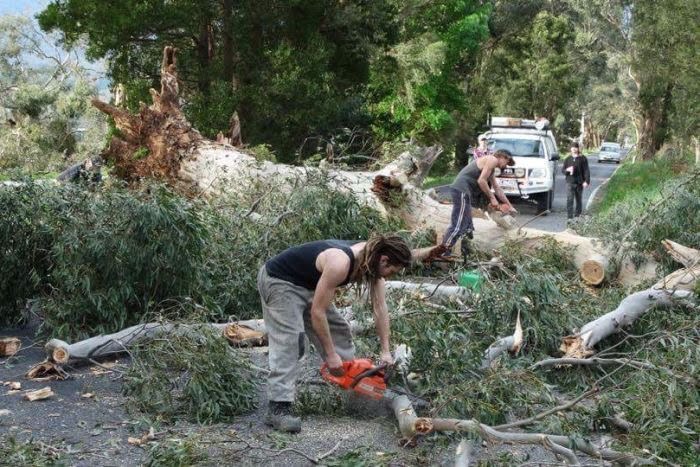As an avid tree lover, and even hugger, it disappoints me to see news broadcasts showing trees that have toppled during yet another major storm. And I have real concerns about what I am seeing with the root mass of these trees.

ANC News 16 October 2016
This tree has a thick trunk with a diameter of at least 1 metre, from what can be seen. So the visible root system is pathetic for the dimension of the above ground trunk and canopy. All of the lateral, anchoring roots appear to have disintegrated, leaving the tree vulnerable to wind damage with the likelihood of toppling in high wind.
I am becoming, in my travels, increasingly aware of road widening or even sealing of roads where verge trees have had their lateral roots trimmed to accommodate the new carriageway. Too often, it can be seen that not only have these lateral roots been cut, but that at least 50 to 60cm of soil has been heaped up at the base of the trees; soil from the road base that has been removed and then dumped on the sides of the road at the base of trees while not being removed from the site.
These practices are fraught with problems later on. The build up of soil will eventually kill the tree – it is a fact. It also weakens the tree as it goes through the death throes, making it susceptible to falling over. And with the associated problem of having one side of the tree’s roots severed, this tree, among often many, will fall.
There is an Australian Standard for determining the Tree Protection Zone (TPZ) around trees to remain in situ, with development occurring around them. This standard was developed in 2009 with the intention of preserving the integrity of trees within construction zones. I firmly believe that these standards are possibly now being ignored or are inadequate. Or the bad practice was effected prior to 2009, and we are only now seeing the results of this bad practice.
Dumping of soil at the base of trees during road widening is not being controlled properly. There are supposed to be overseers of these practices to eliminate this sort of future problem. Is this a potential litigation issue, with the wild winds being blamed as a distraction to prevent litigation? When I consider that the top soil is deemed as useless and so is just dumped against the base of trees, when this quality soil could be recycled elsewhere is ridiculous. Quality soil is hard to come by. This top soil has all of the necessary microbes and mycorrhiza essential to a good soil, and is especially suitable for growing natives. So it is worth money if a buyer can be found.
The current formula for measuring the Tree Protection Zone (TPZ) is based on the diameter of the girth at 1.4 metres from the ground. This then gives the protection zone for any development. But I am currently working with a site where a young, fast growing tree has its protection zone less than the external width of the drip line, so I feel that this tree would be in danger of future damage if the TPZ were the ruling theory. The TPZ here, in my opinion, is inadequate.
If this has happened in my experience, it is quite likely that it has occurred with many other arborists, who maybe have not questioned the formula for determining construction at the base of existing trees. And I believe that this may be the cause of many large, magnificent trees falling, with the power of the wind being blamed for the tree falling.
Eucalypts are supposed to have the capacity to sway in high wind. My home is surrounded by massive eucalypts. We get regular intense wind storms and very rarely get any damage to the trees from these winds. As part of my regular maintenance, I check the base of my trees, to ensure that there is not a build-up of debris at the base and to keep their trunks clean to the ground. Sandy topsoil can erode and build up at the base of trees – this needs to be scraped away if this occurs.
I do not believe that it is necessarily the high wind that has caused the problem. I believe that there is a latent problem behind many of the trees falling.
At the time of planting eucalypts, we double stake using hessian ties. I also believe in formative pruning, although there are those who are against this. I have found it to be excellent practice when done properly. Of course mallees do not have their lower growth removed, and trees like Eucalyptus leucoxylon ssp megalocarpa that naturally put out low laterals as stabilisers are also left alone. But trees that naturally produce a central leader can be formative pruned while young.
The ties are removed as soon as possible, to enable the trees to start their natural rocking motion. This is imperative to the long term viability of the tree that they are able to rock. Trees that have been tightly strangled to a single stake for years should just be removed altogether – they will never be any good and will likely fall later on.
So why does a tree topple in high winds? Often the reasons are that:
1) roots have been severed on one side of the tree that are stabilising roots
2) soil has built up at the base of the tree or,
3) there has been incorrect advice about the protection zone of the tree in a construction zone.
